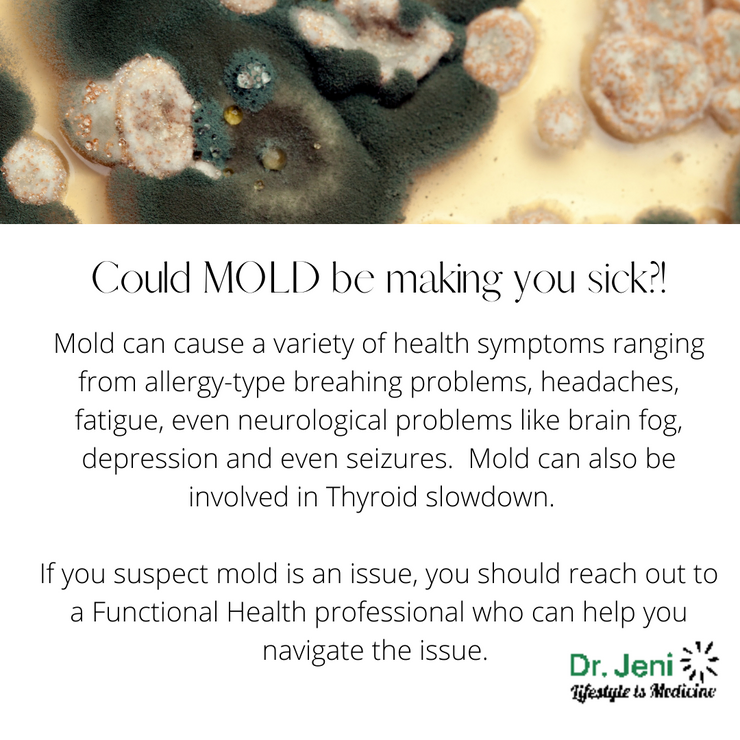You might think that mold exposure means that your home smells stinky or musty. You may think you would see mold growing. I find that very often, that’s not actually a true statement. In fact, I run into many clients that are chronically and mysteriously ill who never suspected mold to be an issue. It’s very sneaky and the medical community almost never talks about it.
What kind of symptoms might you expect if you are exposed to mold? Well… there can be a variety of them. That’s what makes this so tricky. You can have the allergy-type symptoms like runny noise, cough, and trouble breathing. You can also have joint pain, headaches and fatigue. Neurological symptoms like brain fog, depression, anxiety, irritability and even seizures. Exposure to mold is also often a huge piece of the puzzle with a thyroid that has slowed down. Failure to address this piece of the puzzle means that we are treating only the symptoms and not the true cause.
How can mold cause all of these symptoms? There are actually many types of mold. Different types secrete different mycotoxins which are what you make you sick. Depending on the type of mold and mycotoxin involved, the symptoms can be different. That’s another reason mold can be so hard to identify and treat.
Not everyone is equally affected by mold either. This explains why a house full of people can see some people very ill while others seem unaffected. This is because people can be allergic to mold which will make the reactions worse. They can also have a genetic disposition that makes it harder for them to detoxify the various mycotoxins secreted by mold. Different pathways of detoxification are required for different types of mycotoxins so genetic issues with those pathways make it harder for certain people to get rid of the mycotoxins produced by mold.
Mold loves humidity and moisture. This means that it is practically everywhere. The dessert is one place you are relatively safe from mold, but it can even show up there. Undetected leaks in pipes, flooding and high levels of humidity (think turning off an AC in a house for long periods of time and closing the windows like foreclosed or unoccupied homes). It also doesn’t always smell. Sometimes you will notice the characteristic musty smell that can get into clothing and furniture, but it’s very possible not to smell anything.
If you suspect mold is causing some of your health issues, what should you do?
- Look for visible signs of mold – in the bathroom, under the kitchen sink, anywhere you find water. If you can see the mold, clean it up with either 3% hydrogen peroxide, Bleach diluted to 1 cup per gallon of water, undiluted white vinegar or using a product specially designed to kill mold. You can visit this website for more on a great company that has created some great non-toxic products: https://microbalancehealthproducts.com/ Just remember that you can not see a large majority of the mold that might be making you sick.
- Test your home. You can start with a DIY test kit from your local hardware store. If you find an issue, it might be time to call a professional company to help you identify the source of the issue and level of involvement.
- Make sure the cause of mold is addressed and removed. If you have mold growing in the home, you will need to make sure the cause is addressed and removed. This is where the experts are most likely necessary.
- Use of a HEPA plus UV air filter will help remove mold spores from the air. Dehumidifiers help keep moisture in check so mold can not grow.
- Address mold in the laundry by adding a special ingredient to the wash that is designed to kill mold. Here’s a great company that makes such a product: https://microbalancehealthproducts.com/ You can also add either 1/2 cup borax or 1 cup vinegar to you wash cycle to kill mold. Heat will destroy the spores also, so hot water and a hot dryer are good choices, too.
- Test yourself. It might be wise to do some testing on yourself to find out what specific type of mycotoxin is making you sick. These will vary by regions of the country as certain types gravitate to certain areas and by situation. I think it’s important to have this information to know 1) Is this a problem for you and 2) what specific toxin do we need to target with our intervention. Different types of mycotoxins can be killed with different agents. If you know what you are dealing with, you can choose the right combination of treatments to most specifically address what is bothering you. This testing might also involve allergy and genetic testing so we best know how to treat the whole person and get the best results. Make sure you look for a Functional Health professional that understands mold and how to best help.
- Use appropriate interventions to kill off the mycotoxins that are making you sick. Some of the Mycotoxins will respond best to things like activated charcoal, while others respond Activated Carbon or Bentonite clay. It’s also important to support lymphatic drainage and your liver as you detox so you don’t over whelm your body and feel very sick going through this process. Knowing about your genetics can help here, too. If some of your genetic detox pathways are affected you can support those and get results that you might not have otherwise seen. That’s why I feel like it’s important to go through some testing.
I hope you have found this helpful. I believe mold is a much bigger problem than most people realize. If you suspect you have an issue and want to discuss it, please visit this link to schedule a time for a short FREE consultation to see if that might be an issue you need to address.


